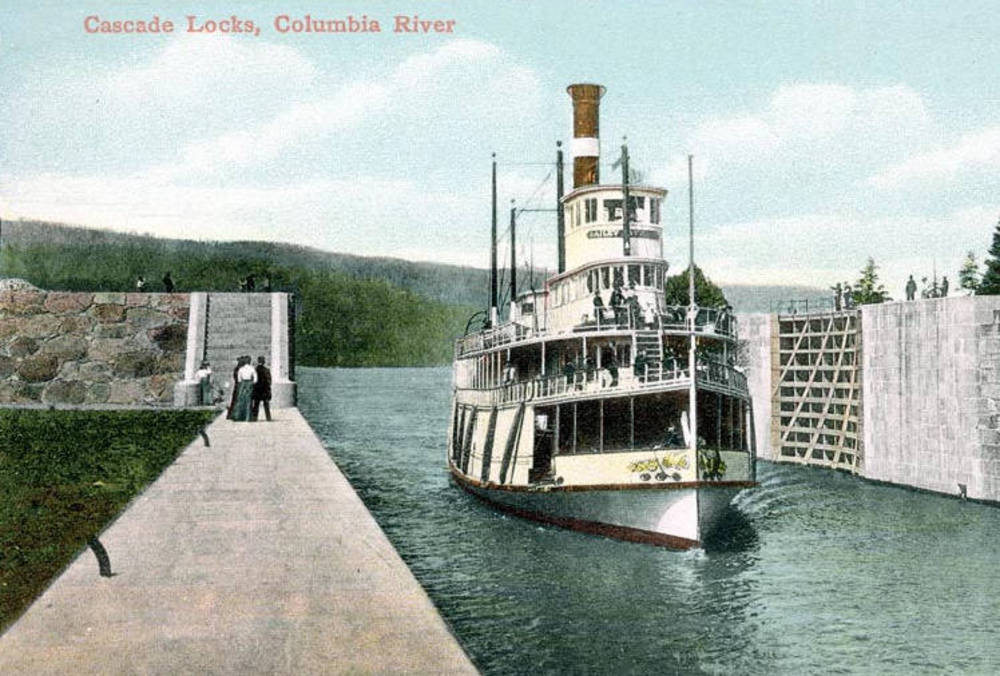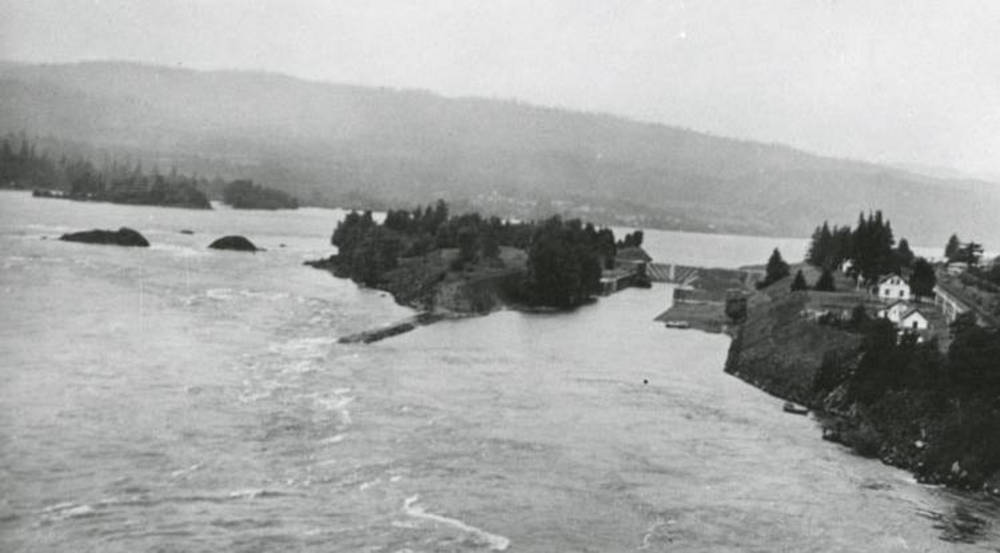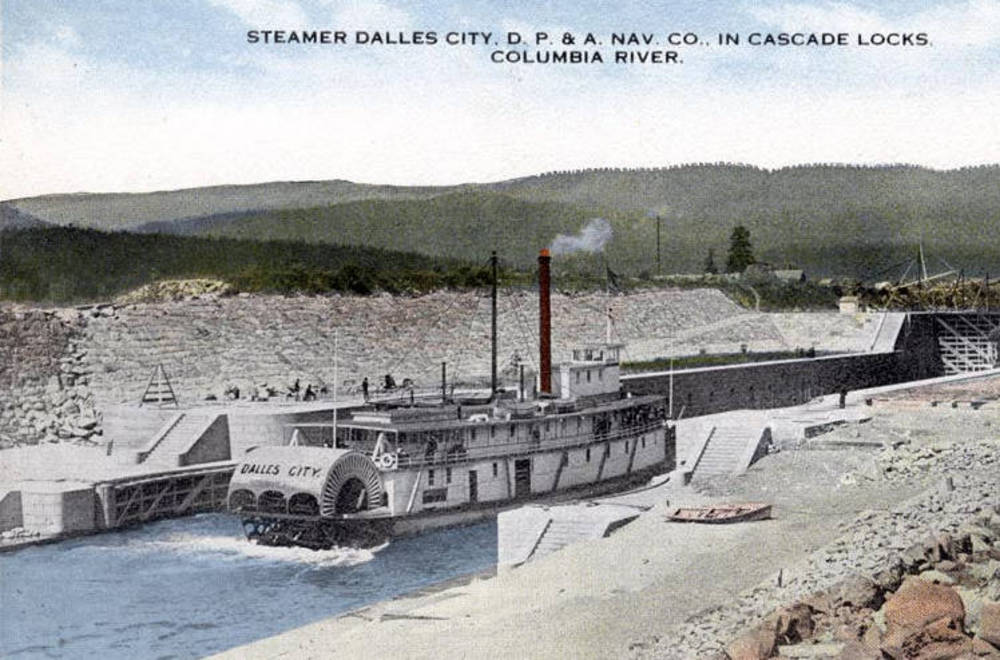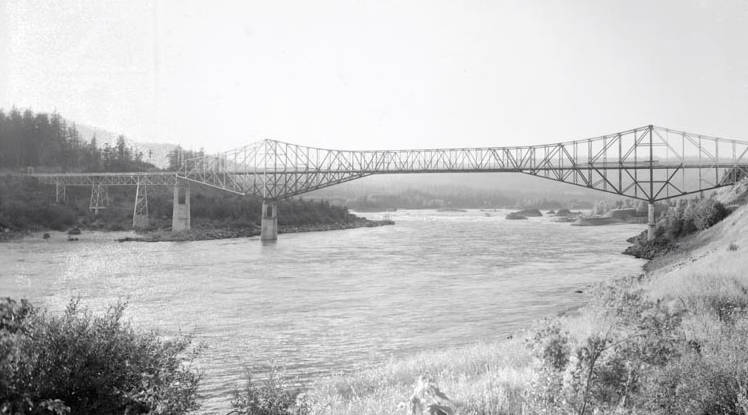A massive ground movement known as the Bonneville Landslide, which occurred about 1200 AD, briefly blocked the Columbia River. The river subsequently broke through the obstruction, and the uneroded portions of the landslide created the rapids known as the Cascades of the Columbia. Native peoples settled along this portion of the Columbia River, and the Cascades became the site of an important aboriginal fishery. The landslide became the basis of the legend known as the Bridge of the Gods.
In the nineteenth century, the town of Cascade Locks, located forty-five miles east of Portland, grew as a result of a federal government project to build a canal and locks at the Cascades of Columbia, the most downstream rapid on the river. Until the construction of the government canal and locks in the late nineteenth century, all river transporation had to portage around the Cascade Rapids.
During the 1850s and 1860s, entrepreneurs had developed a rail portage on the river, which became part of a transportation monopoly owned by the Oregon Steam Navigation Company (OSN). OSN controlled the portages at the Cascades and between The Dalles and Celilo Falls, as well as all steamboats on the river.
Congress authorized the project to build a canal and locks at the Cascade Rapids in 1876. The charge was to support "open-river" navigation on the Columbia between Portland and the agricultural lands of eastern Oregon and Washington. The U.S. Army Corps of Engineers began work on the project in 1878; but difficult working conditions, changing engineering plans, and erratic congressional appropriations delayed opening the canal and locks until November 1896.
When completed, the canal measured 90 feet in width and 3,000 feet in length. It had two locks, one 521 feet long and the other 314 feet long. The locks had a lift of 42 feet (high for the time) and cost $3.8 million to construct.
In 1880, the community of Cascade Locks included about 100 permanent residents and 350 transient construction workers. In the years that followed, the profitability of salmon fishing on the mid-Columbia river aided the gradual growth of the town and the surrounding area. By 1900, about 550 people lived in Cascade Locks and the immediate vicinity.
The scenic beauty of the Columbia River Gorge attracted a summer tourist trade from Portland. During the Lewis and Clark Exposition in Portland in the summer of 1905, 1,417 steamboats passed through the locks, carrying 133,070 passengers.
In 1938, construction of Bonneville Dam and navigation locks a few miles below the Cascades Rapids drowned out the original navigation locks, but it also brought a brief boom to the town of Cascade Locks as construction workers flooded into the community.
During much of the twentieth century, the town of Cascade Locks thrived because of its location adjacent to the Columbia River Highway. It is also where the steel cantilever Bridge of the Gods crosses the Columbia River, connecting Oregon and Washington. In 2020, the population of Cascade Locks was 1,379.
-
![]()
Steamer in Cascade Locks, Columbia River.
Univ. of Oreg. Lib. - Special Coll. and Univ. Archives, ORU_PH035_9562
-
![West approach to Cascade Locks before Bonneville Dam was built (before 1938).]()
Cascade Locks.
West approach to Cascade Locks before Bonneville Dam was built (before 1938). Univ. of Oreg. Lib. - Special Coll. and Univ. Archives, ORU_PH023_0129
-
![Steamer Dalles City in Cascade Locks, Columbia River.]()
Dalles City steamboat at Cascade Locks.
Steamer Dalles City in Cascade Locks, Columbia River. Univ. of Oreg. Lib. - Special Coll. and Univ. Archives, ORU_PH035_9563
Related Entries
-
![Bonneville Dam]()
Bonneville Dam
The U.S. Army Corps of Engineers built and operated Bonneville Lock and…
-
![Bridge of the Gods]()
Bridge of the Gods
In the heart of the Columbia River Gorge, a 1,858-foot-long steel-truss…
-
![Oregon Steam Navigation Company]()
Oregon Steam Navigation Company
Among early business enterprises in Oregon, the Oregon Steam Navigation…
Related Historical Records
Map This on the Oregon History WayFinder
The Oregon History Wayfinder is an interactive map that identifies significant places, people, and events in Oregon history.
Further Reading
Beckham, Stephen, Dow. Prehistory and the History of the Columiba River Gorge National Secnic Area, Oregon and Washington. Eugene, Ore.: Heritage Research Associates, 1988.
Willingham, William F. "Engineering the Cascades Canal and Locks, 1876-1896." Oregon Historical Quarterly 3 (Fall 1987): 229-57.
Willingham, William F. Water Power in the "Wilderness": The History of Bonneville Lock And Dam. Portland, Ore.: Army Engineer District, Portland, 1987.






